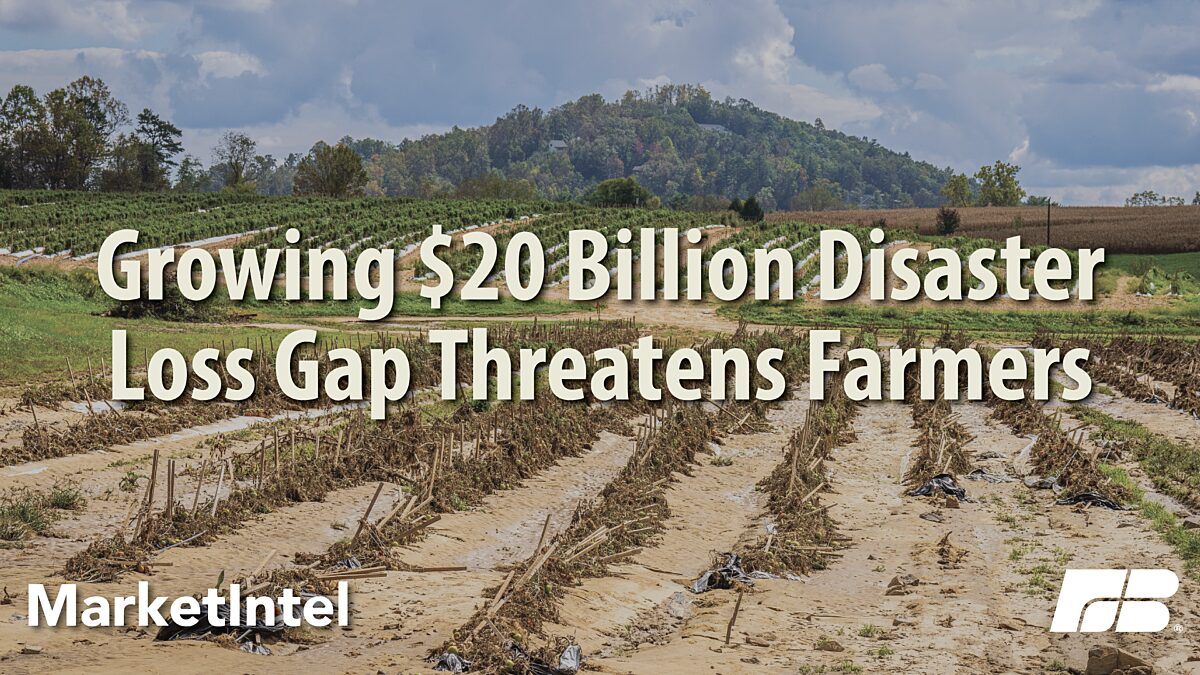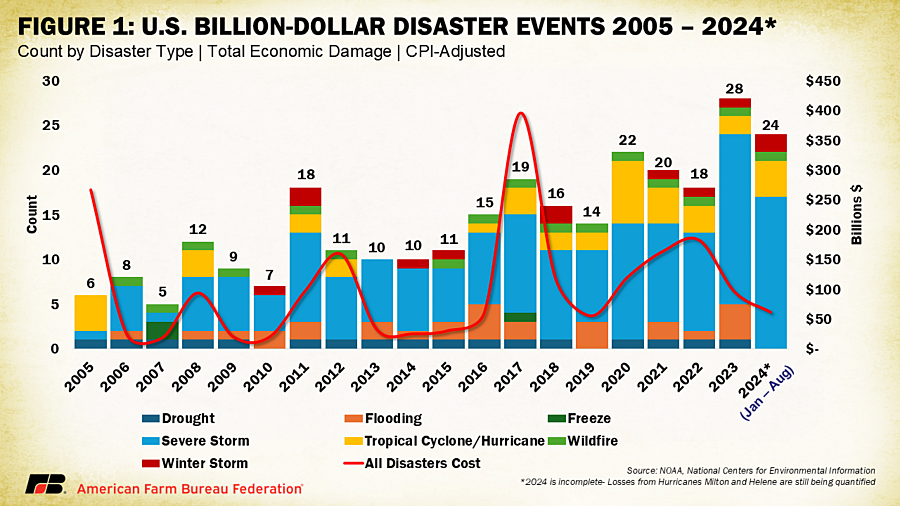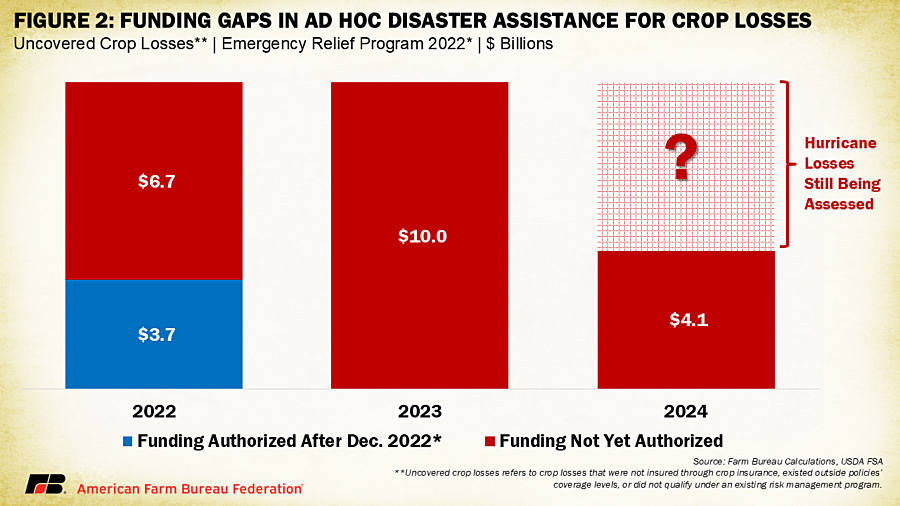Natural Disaster Relief for Farmers: Incomplete Since 2022
TOPICS
Disaster Relief
Daniel Munch
Economist
Weather-related production risks are unavoidable on the farm or ranch. From heavy rain and hail to snow, high winds and drought, farm families prepare their land, plant and harvest each season, fully aware that their livelihoods depend on local weather conditions. In 2024, severe weather has taken center stage, with recovery from hurricanes Helene and Milton just beginning. These powerful storms have been accompanied by hurricanes Debby, Beryl and Francine, relentless wildfires across Texas and New Mexico, and waves of hailstorms, tornadoes and other extreme weather, making this year a challenging one for many communities.
While the scale of 2024 losses is still being tallied, it’s critical to remember that the financial impacts of recent years’ disasters continue to burden farmers. Crop insurance is an invaluable tool, covering more than 50% of weather-related crop losses in recent years, but its coverage has limitations, with policies not available for all crop types in every region. In this Market Intel report “uncovered loss” refers to crop losses that were not insured through crop insurance, existed outside policies’ coverage levels, or did not qualify under an existing risk management program. To date, only one third of 2022 uncovered losses from natural disasters have been addressed through ad hoc relief programs, and uncovered losses from 2023 and 2024 are still unaddressed. As farm economic conditions worsen and natural disasters mount, timely disaster assistance is crucial to protect farmers, ranchers and the rural communities they sustain from lasting harm.
Farmers Still Waiting for Disaster Assistance
According to the National Oceanic and Atmospheric Administration (NOAA), in 2022, there were 18 weather disasters with total economic damage over $1 billion dollars each. This included widespread drought in the West; hurricanes Ian, Fiona and Nicole; derechos; tornadoes and others. NOAA reported that 2022’s $165 billion in total economic losses surpassed 2021 as the third-costliest disaster year in history, behind only 2017’s $346 billion and 2005’s $244 billion. Farm Bureau calculations put total crop and rangeland losses from major 2022 disasters at over $21.48 billion, or 7.7% of NOAA’s total economic impact figure. Of that figure, over $10.48 billion in losses were uncovered losses.
On Dec. 29, 2022, President Biden signed the Disaster Relief Supplemental Appropriations Act, which authorized $3.74 billion for producers who suffered losses to crops, trees, bushes and vines from qualifying causes occurring in calendar year 2022. However, this support covers only 36% of the total uncovered losses farmers faced from major weather events that year, leaving a substantial $6.74 billion gap that has yet to be made whole two years later.
In 2023, 28 weather disasters with damages exceeding $1 billion struck the U.S. coast-to-coast. NOAA reported that 2023 ranked ninth in terms of the total inflation-adjusted economic impact of these events, with industries across the economy experiencing an estimated $92.9 billion hit. Key events included extreme drought along the Gulf Coast, hurricanes Hilary and Idalia, the Hawaiian firestorm and severe Northeast flooding. Farm Bureau estimates indicate that crop and rangeland losses from these 2023 events exceeded $21.94 billion, representing 23.6% of NOAA’s total economic impact. Nearly $10 billion of these losses were uncovered.
While assessments of 2024’s natural disasters are ongoing, preliminary Farm Bureau estimates project billions more in agricultural losses. Early estimates following the same methodology as previous analyses that exclude the recent impacts of Hurricanes Helene and Milton as well as North Dakota fires, indicate uncovered crop and rangeland losses exceeding $4.1 billion. (Losses from Helene and Milton will be billions more.)
Since 2022, farmers and ranchers are facing a cumulative minimum $20 billion loss in crops alone that has not been addressed with ad-hoc relief. These continued losses are severely impacting balance sheets and straining farmers’ financial stability. This $20 billion cumulative loss figure does not include the additional billions in losses to livestock, timber and infrastructure also impacting farmers and ranchers nationwide.
Challenges with the Emergency Relief Program
As of Nov. 3, 2024, $2.8 billion of the authorized $3.74 billion for 2022 crop losses have been disbursed. Given the total need of over $10 billion, this may seem perplexing — but the explanation is straightforward. The 2022 version of the Emergency Relief Program (ERP) included provisions that aggressively lowered benefits to farmers impacted by natural disasters. The program used a method called “progressive factoring” to curb payments. The "progressive factoring" approach applied income-tax-like reductions to disaster assistance, with payments decreasing incrementally based on disaster need, ranging from no reduction for amounts up to $2,000 to an 80% reduction for amounts between $8,001 and $10,000 and a 90% reduction over $10,000. While intended to allocate the limited funds fairly across affected producers, this structure left farmers with the most losses without the support they needed to recover.
The ERP 2022 handbook also includes antiquated definitions for “related conditions” that limit eligibility in ways that overlook common disaster sequences. According to the handbook, "related conditions" must occur directly due to a qualifying disaster event. For example, if a wildfire in September 2022 was followed by rains in November, a resulting mudslide that destroyed crops would not be considered a related condition of the wildfire, rendering the crop loss ineligible. This overlooks the well-known link between wildfires and subsequent mudslides or debris flows, as wildfires often strip away vegetation critical for soil stability.
Another restrictive example is the treatment of tropical storms and depressions. Under the current guidelines, if a tropical storm strengthens into a named hurricane and is later downgraded to a tropical storm or depression, only losses from the named hurricane and its subsequent phases are eligible. Losses from an initial or standalone tropical storm are excluded, despite their direct impact on crop losses. These narrow definitions fail to account for the interconnected nature of weather events, excluding legitimate losses that result from cascading disasters.
Historically, ad hoc disaster programs have imposed stringent eligibility and payment limitation requirements that create barriers for producers seeking adequate relief. ERP, for instance, includes payment caps vary based on crop type (specialty, non-specialty, high-value), disaster type and an applicant’s adjusted gross income (AGI). For farms with diversified operations or small administrative budgets, navigating the program's requirements — such as certifying AGI through a CPA or attorney to access higher payment limits — can present a significant challenge. These complex eligibility standards may unintentionally exclude or limit relief for farmers who lack the resources to meet them, often those in the greatest need. (For a deeper dive into the challenges and innerworkings of ERP 2022 please read: Farmers Can Expect Limited Disaster Support from the Latest ERP Reboot.)
Calls for Timely, Fair and Comprehensive Natural Disaster Assistance
The partial aid provided by ERP 2022, along with mounting losses from recent and ongoing disasters, highlights the urgent need for a robust, timely disaster relief response that only Congress can deliver. Previous relief measures have often been delayed for years, leaving farmers without essential support when they need it most. Some members of Congress are working to address this gap. Rep. David Valadao’s (R-Calif.) H.R. 9889, the Agriculture Disaster Relief Supplemental Appropriations Act of 2024, proposes an additional $14 billion to help farmers and ranchers recover from production, revenue and quality losses caused by extreme weather events in 2023, including hurricanes, droughts, wildfires and more.
With $20 billion in uncovered losses accumulated since 2022, farmers and ranchers are calling for timely disaster aid to keep their operations afloat. The financial strain on farmers without this assistance—or when relief arrives two or more years too late, as is often the case—threatens the viability of farms and the rural communities that depend on them. Immediate, comprehensive relief can enable these producers to recover, rebuild and prepare for future challenges.
Top Issues
VIEW ALL

